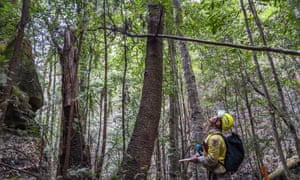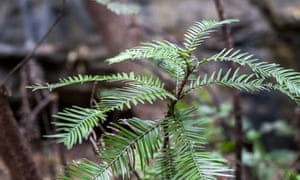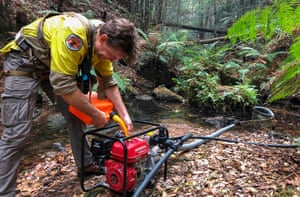
Out of the bushfire catastrophe, Wollemi pines have become a symbol
of survival and all that is good about what humans can do when we are
determined
by James Woodford
by James Woodford
Imagine if more than a quarter of a century ago, bushwalker David
Noble had not stumbled across the stand of Wollemi pines and they had
remained undiscovered.
The trees survive in three stands in just one remote canyon in a massive wilderness to Sydney’s north-west. Until they were found, they were a species clinging to the edge of the precipice of extinction – just one disaster away from vanishing.
A quarter of a century for a species with a lineage going back to the age of dinosaurs is not even a fraction of a millionth of a blip.
And given the monumental effort that has gone into saving this
desperately endangered wild population it is highly likely that had they
not been found in 1994, then the past few months would have seen them
wiped out without anyone ever knowing they still existed. The miracle of
their discovery has become the miracle that has saved them – for now.The trees survive in three stands in just one remote canyon in a massive wilderness to Sydney’s north-west. Until they were found, they were a species clinging to the edge of the precipice of extinction – just one disaster away from vanishing.
A quarter of a century for a species with a lineage going back to the age of dinosaurs is not even a fraction of a millionth of a blip.
I remember the day in a Sydney newsroom almost 20 years ago when an editor at the paper where I worked at the time heard that I was writing a book about the Wollemi pines. Even though the trees’ discovery in 1994 made news on front pages around the world, my boss walked over to my desk, looked me in the eye and said “no one is going to read a fucking book about a tree”.
Implicit in what he said was that no one cared about Wollemi pines enough to read a book about them.

How wrong he was, was demonstrated this week as dramatic news emerged that the trees had been saved from the firestorm of the vast Gospers Mountain fire and people rejoiced.
When I visited the canyon in 1997, I was taken in by helicopter wearing a blindfold and then abseiled into a deep and dark prehistoric environment that was absolutely soaked and waterlogged. At the time it seemed impossible that such a place would ever burn. Now it seems impossible that it didn’t.
The Wollemi pine has been a story that has captured people’s imaginations. It is a tale of high adventure and academic excellence. First, there was a dramatic canyoning exploration trip that led to its discovery, then scientific detective work to determine exactly what that 40-metre-tall tree found by Noble actually was, followed by the quest to understand how it survived unnoticed, so close to Sydney.
Perhaps the significance of the discovery was best captured by a quote given to me by the then director of the Royal Botanic Gardens, Carrick Chambers, on the day the discovery was announced: “This is the equivalent of finding a small dinosaur alive on Earth.”

What Chambers was alluding to and that most people don’t realise is that Wollemi pines are time travellers from a different Australia, from a warmer and wetter planet. Their history stretches back more than 100 million years and they have survived natural climate change that has seen temperatures swing dramatically and sea levels rise and fall by hundreds of metres, multiple times.
The trees tell the story of almost unimaginably deep time. Once, instead of gum trees, Gondwana, of which Australia was a small part, was covered in immense forests of Wollemi pines and their very close relatives. These ancient trees deposited so much pollen that it is still found as fossils around the southern hemisphere, retrieved by geologists who find evidence of the trees in cores, from places like Bass Strait, that are kilometres thick.
Then, 10 million years ago, the trees begin to vanish from the fossil pollen record and two million years ago they disappeared altogether, indicating that the climate had shifted in a way that made their widespread survival untenable.
Since then as the planet shifted towards icier, colder, drier conditions any surviving populations of the trees would have slowly shrunk, become separated and forced to retreat into the last refuges of wet deep rainforest canyons. After people arrived in Australia and widespread burning was practiced, their fate was sealed to imprisonment in a single deep gorge.

It is also about the ongoing effort to keep the location of the trees secret and protected from fungal pathogens.
The fact that out of this catastrophe, Wollemi pines have become a symbol of survival and all that is good about what we can do when we are determined to protect something, shows that all is not lost as man-made climate change tightens its grip.
- James Woodford is the author of The Wollemi Pine: the incredible discovery of a living fossil from the age of the dinosaurs, Text Publishing
No comments:
Post a Comment